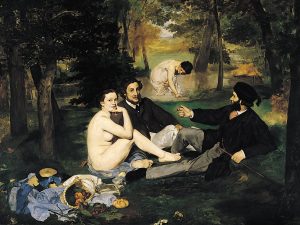Le Déjeuner Sur L’herbe, a Work Of Art to Discover At The Musée d’Orsay
Le Déjeuner sur l’herbe, completed in 1863 thanks to the inspiration of painter Edouard Manet, is now on display at the Musée d’Orsay. This work, which was controversial after its first shows, first named Le Bain then La Partie Carrée, is noteworthy for the consistency of its production and contrasts with the tradition of the time.
A painting that upsets established codes
Le Déjeuner sur l’herbe is at first sight depicting a peaceful picnic scene in an undergrowth. A nude woman who watches the spectator is joined by two fully dressed men, while another bathes in the background at the pool. The food, arranged or overturned on scattered clothing, is visible in the foreground. The job, studied by a painter, unites a still life, portraits and a landscape.
Manet, with his willingness to break free, appeals to his masters’ classics but transgresses all the rules: unrespected viewpoints, rugged contrasts preferred to smooth gradients, barely sketched landscape. The painter tries to caricature the bourgeois masculinity of his period concealed under a romanticism of prime importance.
The canvas, on display at the Salon des refusés in May 1863, created an artistic and moral scandal. The spilled basket serves as a sign of desire and a passage from allegory to eroticism.
Critics also decried the harsh reality of the woman believing her modesty associated with the break with the art codes of the period, and the work has been removed from the Salon.
Claude Manet, a progressive artist
Claude Manet, a precursor to modern art that he liberated from academicism-the taste for historical or oriental depictions-is a painter born in Paris in 1832, where he died in 1883. When he approaches impressionism through the themes chosen, those who regard him as one of the fathers of this current do so wrongly: he is distinguished by his concern for realism and his refusal to use light treatment techniques.
After the scandal linked to his paintings Lola de Valence, La Femme veuve, Combat de taureau, Le Déjeuner sur l’herbe and Olympia Manet was rejected from official exhibitions. For the latter, he will be defended against his detractors by Émile Zola of which he painted a portrait. Among his friends were impressionist artists, notably Claude Monet, Auguste Renoir and Berthe Morisot. In contact with them, he abandoned studio painting for open-air painting in Argenteuil and Gennevilliers.
Still lifes, particularly decorative ones, owed Manet greater nobility. As illustrated by his work L’asparge, they are decorated with dissonant colors. The painter created many male and female portraits, too. His death at 51 from syphilis and gangrene leaves more than 400 orphan paintings.

The Orsay museum: a must-see in Paris
A few words about this Parisian museum that houses, in addition to Le Déjeuner sur l’herbe, a collection that shows Western art in all its richness between 1848 and 1914. There, on some 57,400 m² paintings, sculpture, graphic arts, decorative arts, architecture and photography are gathered to constitute one of Europe’s largest museums dealing with this period.
Inaugurated in 1986 under the impetus of Valéry Giscard d’Estaing, it takes place at the old station in Orsay built between 1898 and 1900 by Victor Laloux instead of the Palais d’Orsay built in 1810, but burnt down during the Paris Commune in 1871.
We can note the presence of 1,100 impressionistic and post-impressionist canvases among the collections of paintings. Notable sculptures are also on display, such as Jules Cavelier’s Sleeping Penelope or Edgar Degas’ La Petite Danseuse de quatorze ans, not to mention those by Rodin or Camille Claudel. Finally, let’s cite the photo collection which includes over 44,000 works. It is currently the Museum of Orsay that inaugurates the existence of this artistic form in a museum.
Claude Manet marked his time, both because of his vision of painting and because of the new ideas he brought, so disturbing that at first glance they may have seemed. The Orsay Museum now houses the remarkable artist’s 39 paintings and 12 pastels. Le Déjeuner sur l’herbe is a sign of his work, which should be appreciated as soon as possible!


